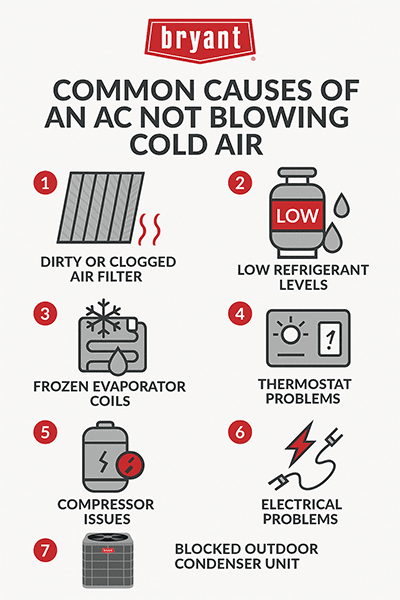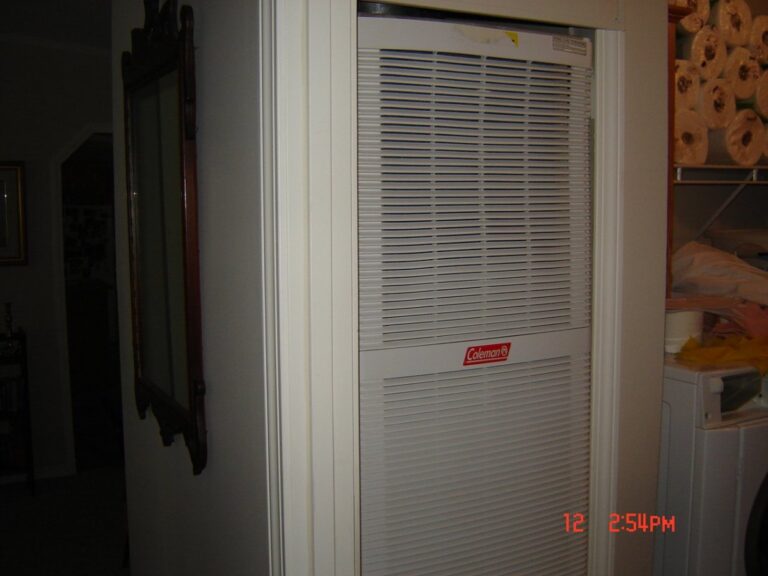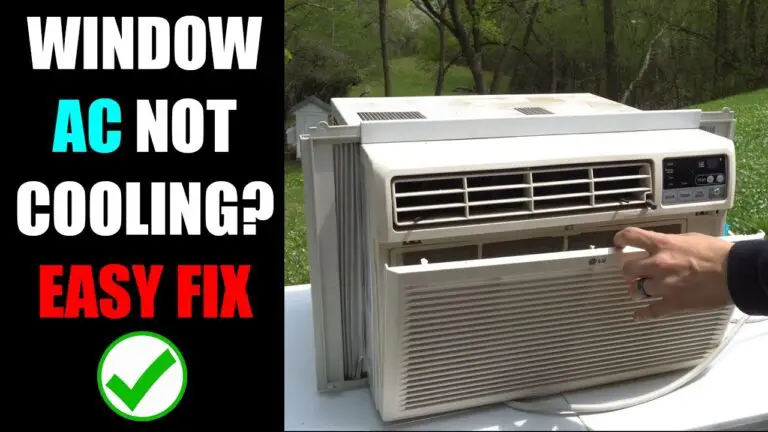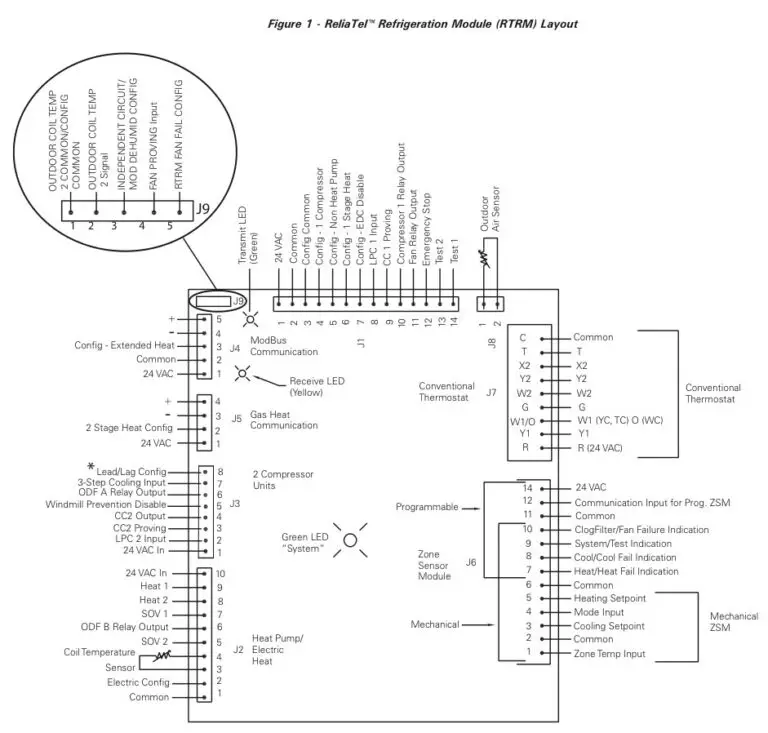Bryant AC Unit Troubleshooting: Quick Fixes for Common Issues
Is your Bryant AC unit acting up? When your cooling system isn’t performing as it should, it can leave you feeling frustrated and uncomfortable, especially on those scorching days.
But don’t worry—you’re not alone, and you don’t have to call in a professional just yet. Many common AC issues can be identified and resolved with a little troubleshooting on your end. In this guide, we’ll walk you through the most common problems Bryant AC units face and the straightforward steps you can take to fix them.
Whether it’s strange noises, warm air blowing from the vents, or a unit that won’t turn on, we’ve got you covered. Stick around, and you’ll feel more confident in tackling these issues, saving both time and money. Let’s get your home cool and comfortable again!
Common Problems With Bryant Ac Units
When your Bryant AC unit starts acting up, it can be frustrating, especially during the peak of summer. Many homeowners encounter recurring issues, and some of these are surprisingly easy to fix. Knowing the common problems can save you time, money, and the discomfort of a sweltering home.
1. Dirty Air Filters
A clogged air filter is one of the most frequent issues with Bryant AC units. When filters are dirty, airflow becomes restricted, forcing your AC to work harder. This can lead to higher energy bills and even cause your unit to overheat.
To avoid this, check and replace your air filter every 1-3 months. If you notice weak airflow or dust buildup near vents, the filter could be the culprit. Set a reminder on your phone to keep this simple task from slipping through the cracks.
2. Thermostat Malfunctions
Ever set your AC to a cool temperature, but it doesn’t kick on? A malfunctioning thermostat might be to blame. It could be as simple as dead batteries or as complex as a wiring issue.
Before calling a technician, replace the batteries and double-check the settings. If the problem persists, consider upgrading to a programmable thermostat for better control.
3. Refrigerant Leaks
Refrigerant is the lifeblood of your AC system, and leaks can seriously impact performance. Signs include insufficient cooling, ice buildup on coils, or strange hissing noises.
If you suspect a leak, don’t attempt a DIY fix. Handling refrigerants requires special tools and certifications. Instead, schedule a professional inspection immediately to prevent further damage.
4. Frozen Evaporator Coils
When your AC runs but doesn’t cool, frozen evaporator coils might be the issue. This happens when airflow is restricted or refrigerant levels are low.
Turn off the unit and let the coils thaw completely. Then, inspect the air filter and ensure vents are unobstructed. If the issue continues, call a technician to check for underlying problems.
5. Electrical Issues
Frequent tripping of circuit breakers or a completely unresponsive AC could indicate electrical problems. Faulty wiring or a failing capacitor might be the cause.
Never ignore electrical issues, as they can pose safety risks. A licensed HVAC technician can diagnose and resolve these problems safely.
6. Drainage Problems
AC units remove moisture from the air, but if the drain line is clogged, water can back up into your home. This can lead to water damage and mold growth.
Check the drain line for clogs or algae buildup. Use a wet/dry vacuum to clear blockages, or flush the line with a mixture of water and vinegar to keep it clean.
What’s the most annoying issue you’ve faced with your AC? Share your experience in the comments—your story might help someone else troubleshoot their unit!
Signs Your Bryant Ac Unit Needs Attention
Your Bryant AC unit is essential for keeping your home comfortable during hot weather. But like any machine, it can show signs of wear or issues over time. Recognizing these signs early can save you from costly repairs and ensure your unit keeps running efficiently.
1. Unusual Noises
Does your AC sound different lately? Clicking, buzzing, or banging noises might signal mechanical issues. For example, a loose part or damaged fan blade could be the culprit. If the sound persists, it’s time to call a professional.
2. Weak Airflow
Is the air from your vents barely noticeable? Weak airflow often means something is blocking the ducts or the blower motor is failing. A dirty air filter can also reduce airflow, so check and replace it if needed.
3. Warm Air Instead Of Cool
If your AC is blowing warm air, it’s not doing its job. This could be due to refrigerant leaks, a faulty compressor, or thermostat issues. Don’t wait—warm air on a hot day is frustrating and a clear sign your unit needs attention.
4. Strange Smells
Does your AC smell musty or burnt when it runs? A musty smell may indicate mold in the unit or ducts. A burnt smell could mean electrical problems. Either way, strange smells shouldn’t be ignored.
5. High Energy Bills
Have your energy bills suddenly spiked? An inefficient AC unit can cause higher energy consumption. Check for signs like frequent cycling or poor cooling performance to pinpoint the issue.
6. Frequent Cycling
Does your AC turn on and off too often? This can be a sign of thermostat problems or an oversized unit. Frequent cycling wastes energy and puts unnecessary strain on the system.
7. Water Or Moisture Leaks
Seeing water pools near your AC? Your unit’s drain tube may be clogged, or it could be a refrigerant leak. Both can lead to bigger problems if left untreated.
Paying attention to these signs can help you catch issues early and keep your Bryant AC running smoothly. Which of these warning signs have you noticed recently? Identifying them might be easier than you think.
Ac Unit Not Cooling Properly
Nothing is more frustrating than a Bryant AC unit that’s not cooling properly, especially during the peak of summer. You’ve set the temperature, but the room still feels like a sauna. Before you call for professional help, there are a few troubleshooting steps you can take to solve the issue yourself.
Checking The Thermostat Settings
Start with the simplest solution—check your thermostat. Is it set to “Cool” and not “Fan” or “Heat”? Double-check the temperature you’ve selected; sometimes, it’s set higher than you intended.
If you’re using a programmable thermostat, ensure the schedule aligns with your cooling needs. A power outage may have reset it. Take a moment to verify everything is in working order—it’s a small step that can save you big headaches.
Inspecting Air Filters For Blockages
Dirty air filters can choke your AC unit and reduce its cooling efficiency. Pull out the filters and hold them up to the light. If you can’t see through them, it’s time for a cleaning or replacement.
Clogged filters restrict airflow, forcing your AC to work harder than it should. Replace the filters every 1-3 months, especially during heavy use. A fresh filter can make a noticeable difference in how well your AC cools.
Examining Refrigerant Levels
Low refrigerant levels can be a major culprit when your AC isn’t cooling properly. Refrigerant is the lifeblood of your AC, absorbing heat from your home and releasing it outside. Without enough of it, your unit can’t do its job effectively.
Unfortunately, checking and refilling refrigerant isn’t a DIY-friendly task. If you suspect a refrigerant issue, call a licensed HVAC technician to inspect for leaks and recharge the system. Ignoring this can lead to bigger, more expensive problems down the road.
Are you noticing other signs like ice on the coils or unusual hissing noises? These might also point to refrigerant trouble and shouldn’t be overlooked.
Addressing these three areas—thermostat settings, air filters, and refrigerant levels—can often resolve cooling issues. It’s always smart to eliminate the basics before assuming the worst. What step will you try first to get your Bryant AC cooling again?

Credit: www.bryant.com
Unusual Noises From The Unit
Hearing unusual noises from your Bryant AC unit can be concerning. These noises often signal underlying issues that require attention. Ignoring them may lead to bigger problems. Understanding the source of the noise can help address the issue effectively.
Loose Or Damaged Components
Rattling or banging sounds might indicate loose or damaged components. Screws, panels, or internal parts may shake during operation. Inspect the unit carefully for loose screws or disconnected parts. Tighten or replace any problematic components to stop the noise. Always turn off the power before inspecting the unit.
Fan Motor Issues
A grinding or screeching noise may point to fan motor issues. Dirt or debris can clog the fan motor, causing abnormal sounds. Bearings inside the motor may also wear out over time. Cleaning the motor and lubricating the bearings can solve these problems. If the noise persists, consider calling a professional.
Compressor Troubles
A loud buzzing or humming noise often signals compressor issues. The compressor is critical for cooling and must operate smoothly. Electrical problems or refrigerant levels might create these unusual sounds. Address these issues promptly to prevent further damage. A certified technician can diagnose and fix compressor-related problems.
Ac Unit Not Turning On
Is your Bryant AC unit refusing to turn on, leaving your home feeling like an oven? Don’t panic just yet—there are several reasons why your unit might not be working, and most of them are easy to troubleshoot. Let’s dive into the specifics and get your AC back to cooling your space.
Power Supply And Circuit Breaker
First, check if your AC is getting power. It might sound obvious, but you’d be surprised how often power supply issues are the culprit.
Head to your breaker box and inspect if the circuit breaker connected to your AC has tripped. If it has, flip it back on. A tripped breaker usually happens due to power surges or overloading.
If the breaker keeps tripping after resetting, it could be a sign of a deeper electrical issue. At this point, calling an electrician might save you time and frustration.
Faulty Capacitor Check
The capacitor is a small but essential part of your AC unit. It helps start the compressor and fan motors. If it’s faulty, your unit might not turn on at all.
Listen for a clicking sound when you try to start the AC. Clicking often indicates capacitor failure. You can visually inspect it too—swollen or leaking capacitors are a clear sign they need replacing.
Replacing a capacitor is a straightforward fix, but if you’re not comfortable working with electrical components, leave it to a professional.
Thermostat Connection Problems
Sometimes the issue isn’t with the AC unit itself but with the thermostat. Check if your thermostat is set to “cool” mode and the temperature is lower than your room temperature.
If the thermostat isn’t communicating with the AC, inspect the wiring connections. Loose or damaged wires can prevent signals from reaching your unit.
If you’re using a battery-powered thermostat, try replacing the batteries. You’d be surprised how often dead batteries cause unnecessary headaches.
So, what’s the verdict? Did one of these fixes work for your AC? Troubleshooting is all about narrowing down the possibilities. The key is to start simple and work your way up. Don’t hesitate to share your experience or ask questions in the comments below!
Water Leaks Around The Ac Unit
Water leaking around your Bryant AC unit can cause concern. It may lead to damage if left unresolved. The issue usually stems from a few common problems. Identifying the root cause helps you take the necessary steps to fix it.
Below are common reasons for water leaks and how to troubleshoot them. By addressing these issues, you can prevent further damage to your AC unit and home.
Clogged Drain Line
The drain line removes condensation from your AC system. Over time, dirt and debris can block it. A clogged line forces water to back up and leak around the unit. To fix this, check for blockages in the drain pipe. Use a wet/dry vacuum or a plumbing snake to clear the line. Regular maintenance helps prevent future clogs.
Frozen Evaporator Coils
Frozen evaporator coils can lead to water leaks. Ice on the coils melts and causes excess water to drip. This often happens due to restricted airflow or low refrigerant levels. Check your air filters and replace dirty ones. Ensure vents and registers are not blocked. If the issue persists, consult a professional to check for refrigerant problems.
Inspecting The Condensate Pump
The condensate pump helps drain water from your AC system. If the pump fails, water can collect and leak. Inspect the pump for damage or improper operation. Ensure it’s plugged in and receiving power. Clean the pump and its components to remove dirt or debris. Replace the pump if it no longer functions properly.
Unpleasant Odors From The Ac Unit
Strange smells coming from your Bryant AC can be frustrating. These odors often indicate underlying issues that require attention. Identifying the source of the smell is key to resolving the problem effectively.
Below are common causes of unpleasant odors and steps to troubleshoot them.
Cleaning The Air Filters
Dirty air filters can trap dust, debris, and bacteria over time. This accumulation can lead to unpleasant smells circulating through your home. Check your filters regularly to ensure they are clean.
Remove the filters and inspect them for dirt or damage. If they are reusable, rinse them with water and let them dry completely before reinstalling. Replace disposable filters every few months for optimal performance.
Mold Or Mildew In Ductwork
Mold or mildew growth inside the ductwork can produce musty odors. Moisture buildup in ducts creates an ideal environment for mold. Inspect ducts for visible signs of mold or dampness.
Use a flashlight to check deep areas in the ductwork. If mold is present, clean the affected areas using a mold removal solution. You may need professional help for extensive mold problems.
Addressing Drain Pan Issues
The drain pan collects excess water from the AC unit. Over time, stagnant water can lead to bacteria growth and unpleasant smells. Check the drain pan for clogs or standing water.
Clean the pan using a mild detergent and ensure the drain line is clear. Regular maintenance of the drain pan can prevent odors and improve system efficiency.

Credit: bryantheatingcooling.com
Warm Air Instead Of Cool Air
Is your Bryant AC blowing warm air instead of cool air? It’s frustrating, especially on a hot day when you need relief the most. Don’t panic—this issue often has simple fixes that you can handle without calling a technician right away. Let’s dive into some practical troubleshooting steps.
Inspecting The Outdoor Unit
Start by checking the outdoor unit. Is it covered in leaves, dirt, or debris? A blocked outdoor unit can’t release heat effectively, causing warm air indoors.
Clear away any obstructions and ensure there’s enough space around the unit for proper airflow. Also, listen carefully—if you hear strange noises or silence, the fan or compressor may need attention.
Keep an eye on the unit while it’s running. Does it seem sluggish or overly hot? These could be signs of deeper issues that need professional help.
Checking Refrigerant Lines
Refrigerant lines are like the veins of your AC system, moving coolant that keeps your home cool. If these lines are damaged or leaking, your AC will struggle to work efficiently.
Look for visible signs like frost or oily residue on the refrigerant lines. These can indicate a problem. If the lines look worn or bent, they might need replacement.
You can’t refill refrigerant yourself—it’s a job for licensed technicians. But spotting the issue early can save you money and prevent bigger problems.
Dirty Or Damaged Coils
Dirty coils are another common culprit behind warm air. The coils inside your AC unit are responsible for absorbing heat, but dirt can block this process.
Check the condition of both the evaporator and condenser coils. Are they dusty or covered in grime? Use a soft brush or specialized coil cleaner to gently clean them.
If the coils appear bent or damaged, it’s time to call an expert. Ignoring damaged coils can lead to long-term efficiency problems and higher energy bills.
What’s your AC telling you? Pay attention to these signs and act promptly. A little troubleshooting could be all it takes to get your Bryant AC cooling again.
Diy Maintenance Tips For Bryant Ac Units
Regular maintenance keeps Bryant AC units running efficiently. Simple DIY tasks can prevent common issues. Regular care also helps extend the life of your unit. These tips will guide you in maintaining your Bryant AC effectively.
Regular Filter Replacement
Dirty filters reduce airflow and strain your Bryant AC unit. Check the filter every month, especially during peak cooling seasons. Replace it every 30 to 90 days, depending on usage. Homes with pets or allergies may need more frequent replacements. Use filters compatible with Bryant units for the best results.
Cleaning The Outdoor Unit
The outdoor unit can collect dirt, leaves, and debris. This buildup blocks airflow and affects cooling efficiency. Turn off the power before cleaning the unit. Use a soft brush or vacuum to remove dirt from the fins. Keep the surrounding area clear of plants or objects for better airflow.
Scheduling Professional Inspections
Annual professional inspections ensure your Bryant AC runs smoothly. Technicians can spot issues that DIY tasks may miss. They also check for refrigerant leaks and electrical problems. Schedule inspections before the cooling season begins for optimal performance. This step helps avoid costly repairs in the future.
When To Call A Professional
Troubleshooting a Bryant AC unit can resolve minor issues. But some problems need expert attention. Knowing when to call a professional saves time and prevents further damage. This section explains situations that require expert help.
Frequent System Shutdowns
An AC that turns off frequently signals a serious issue. It could be a failing component or electrical problem. A professional technician can diagnose and repair it safely.
Unusual Noises
Loud banging, hissing, or screeching sounds are not normal. These noises often indicate mechanical wear or internal damage. Contact an expert to inspect and fix the issue immediately.
Constant Water Leaks
Water pooling around the unit shows a drainage issue. This could damage your AC or surrounding area. A licensed technician can address the root cause effectively.
Warm Air From Vents
If your Bryant AC blows warm air, it needs expert attention. This issue could involve refrigerant leaks or compressor problems. A professional can restore cooling efficiency.
Unresponsive Thermostat
An unresponsive thermostat makes it hard to control the AC system. This could be due to wiring issues or internal malfunctions. A qualified technician can resolve the problem quickly.
Electrical Issues
Tripped breakers or burning smells signal electrical malfunctions. Attempting repairs without proper knowledge can be dangerous. Leave these issues to trained professionals.
High Energy Bills
Unusually high energy bills might point to AC inefficiency. A technician can identify and fix the underlying problem. This helps maintain your unit’s performance and saves money.

Credit: www.youtube.com
Conclusion
Troubleshooting a Bryant AC unit doesn’t have to feel overwhelming. Start with basic checks like filters, thermostat settings, and power supply. Regular maintenance can prevent many issues before they happen. If problems persist, consulting a professional may be the best choice.
Always prioritize safety when handling electrical components or refrigerants. A well-maintained system ensures better cooling and energy efficiency. Keep your AC in good shape to stay comfortable all year round. By addressing issues early, you can save time, money, and stress.
Proper care keeps your Bryant AC running smoothly for years to come.




